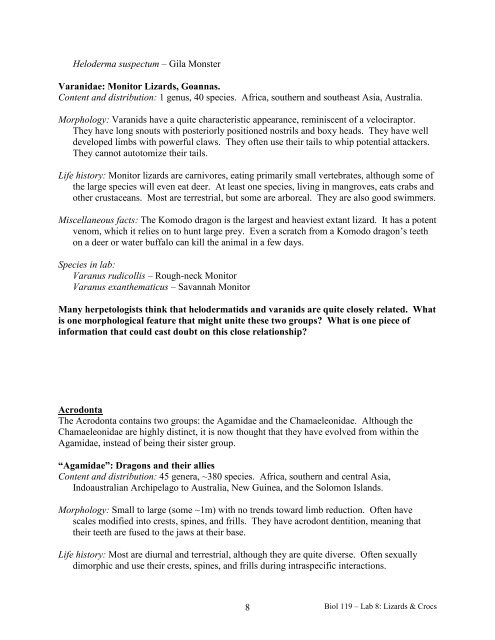Biol 119 – Herpetology Lab 8: Lizard and ... - Clark University
Biol 119 – Herpetology Lab 8: Lizard and ... - Clark University
Biol 119 – Herpetology Lab 8: Lizard and ... - Clark University
Create successful ePaper yourself
Turn your PDF publications into a flip-book with our unique Google optimized e-Paper software.
Heloderma suspectum <strong>–</strong> Gila Monster<br />
Varanidae: Monitor <strong>Lizard</strong>s, Goannas.<br />
Content <strong>and</strong> distribution: 1 genus, 40 species. Africa, southern <strong>and</strong> southeast Asia, Australia.<br />
Morphology: Varanids have a quite characteristic appearance, reminiscent of a velociraptor.<br />
They have long snouts with posteriorly positioned nostrils <strong>and</strong> boxy heads. They have well<br />
developed limbs with powerful claws. They often use their tails to whip potential attackers.<br />
They cannot autotomize their tails.<br />
Life history: Monitor lizards are carnivores, eating primarily small vertebrates, although some of<br />
the large species will even eat deer. At least one species, living in mangroves, eats crabs <strong>and</strong><br />
other crustaceans. Most are terrestrial, but some are arboreal. They are also good swimmers.<br />
Miscellaneous facts: The Komodo dragon is the largest <strong>and</strong> heaviest extant lizard. It has a potent<br />
venom, which it relies on to hunt large prey. Even a scratch from a Komodo dragon’s teeth<br />
on a deer or water buffalo can kill the animal in a few days.<br />
Species in lab:<br />
Varanus rudicollis <strong>–</strong> Rough-neck Monitor<br />
Varanus exanthematicus <strong>–</strong> Savannah Monitor<br />
Many herpetologists think that helodermatids <strong>and</strong> varanids are quite closely related. What<br />
is one morphological feature that might unite these two groups? What is one piece of<br />
information that could cast doubt on this close relationship?<br />
Acrodonta<br />
The Acrodonta contains two groups: the Agamidae <strong>and</strong> the Chamaeleonidae. Although the<br />
Chamaeleonidae are highly distinct, it is now thought that they have evolved from within the<br />
Agamidae, instead of being their sister group.<br />
“Agamidae”: Dragons <strong>and</strong> their allies<br />
Content <strong>and</strong> distribution: 45 genera, ~380 species. Africa, southern <strong>and</strong> central Asia,<br />
Indoaustralian Archipelago to Australia, New Guinea, <strong>and</strong> the Solomon Isl<strong>and</strong>s.<br />
Morphology: Small to large (some ~1m) with no trends toward limb reduction. Often have<br />
scales modified into crests, spines, <strong>and</strong> frills. They have acrodont dentition, meaning that<br />
their teeth are fused to the jaws at their base.<br />
Life history: Most are diurnal <strong>and</strong> terrestrial, although they are quite diverse. Often sexually<br />
dimorphic <strong>and</strong> use their crests, spines, <strong>and</strong> frills during intraspecific interactions.<br />
8<br />
<strong>Biol</strong> <strong>119</strong> <strong>–</strong> <strong>Lab</strong> 8: <strong>Lizard</strong>s & Crocs
















